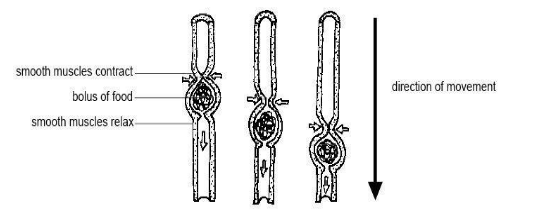
In the food pipe the bolus is propelled into the stomach by peristaltic movements. Represent this action with a diagram.
Answer
491.1k+ views
1 likes
Hint: Peristaltic movement usually occurs in oesophagus also known as food pipe. They are defined as rhythmically contraction and relaxation of food pipe and generating wave-like movement in order to push the food into the stomach. In the oesophagus these movements push forward downwards. In the stomach these movements churns swallowed food and help the food to mix with digestive juices. Almonds are the best food that increases the rate of peristaltic movements.
Complete answer:

The chemical process of digestion is initiated in the oral cavity. It is done by the hydrolytic action of the carbohydrate splitting enzyme, the salivary amylase. This enzyme hydrolysed about 30 percent of starch into a disaccharide-maltose (At optimum pH 6.8). The lysozyme present in the saliva acts as an antibacterial agent that prevents infections.
This mass of food (bolus) is then pushed down through pharynx into oesophagus. This process is called Swallowing or deglutition. This bolus further passes down from the oesophagus through successive waves of muscular contractions. These muscular contractions are called peristalsis. There is a sphincter between oesophagus and stomach called gastro-oesophageal sphincter. It controls the passage of food into the stomach.
Note: The stomach stores the food for 4-5 hours, The food mixes thoroughly with the acidic gastric juice of the stomach by the churning movements of its muscular wall and is called the chyme The proenzyme pepsinogen, on exposure to hydrochloric acid gets converted into the active enzyme pepsin, the proteolytic enzyme of the stomach. Pepsin converts proteins into proteoses and peptones (peptides).
Complete answer:

The chemical process of digestion is initiated in the oral cavity. It is done by the hydrolytic action of the carbohydrate splitting enzyme, the salivary amylase. This enzyme hydrolysed about 30 percent of starch into a disaccharide-maltose (At optimum pH 6.8). The lysozyme present in the saliva acts as an antibacterial agent that prevents infections.
This mass of food (bolus) is then pushed down through pharynx into oesophagus. This process is called Swallowing or deglutition. This bolus further passes down from the oesophagus through successive waves of muscular contractions. These muscular contractions are called peristalsis. There is a sphincter between oesophagus and stomach called gastro-oesophageal sphincter. It controls the passage of food into the stomach.
Note: The stomach stores the food for 4-5 hours, The food mixes thoroughly with the acidic gastric juice of the stomach by the churning movements of its muscular wall and is called the chyme The proenzyme pepsinogen, on exposure to hydrochloric acid gets converted into the active enzyme pepsin, the proteolytic enzyme of the stomach. Pepsin converts proteins into proteoses and peptones (peptides).
Recently Updated Pages
Master Class 11 Economics: Engaging Questions & Answers for Success

Master Class 11 Business Studies: Engaging Questions & Answers for Success

Master Class 11 Accountancy: Engaging Questions & Answers for Success

Master Class 11 English: Engaging Questions & Answers for Success

Master Class 11 Computer Science: Engaging Questions & Answers for Success

Master Class 11 Maths: Engaging Questions & Answers for Success

Trending doubts
State and prove Bernoullis theorem class 11 physics CBSE

1 ton equals to A 100 kg B 1000 kg C 10 kg D 10000 class 11 physics CBSE

State the laws of reflection of light

One Metric ton is equal to kg A 10000 B 1000 C 100 class 11 physics CBSE

1 Quintal is equal to a 110 kg b 10 kg c 100kg d 1000 class 11 physics CBSE

Difference Between Prokaryotic Cells and Eukaryotic Cells




